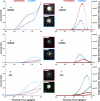Laser-Treated Screen-Printed Carbon Electrodes for Electrochemiluminescence imaging
- PMID: 39735830
- PMCID: PMC11672215
- DOI: 10.1021/cbmi.4c00070
Laser-Treated Screen-Printed Carbon Electrodes for Electrochemiluminescence imaging
Abstract
Electrochemiluminescence (ECL) is nowadays a powerful technique widely used in biosensing and imaging, offering high sensitivity and specificity for detecting and mapping biomolecules. Screen-printed electrodes (SPEs) offer a versatile and cost-effective platform for ECL applications due to their ease of fabrication, disposability, and suitability for large-scale production. This research introduces a novel method for improving the ECL characteristics of screen-printed carbon electrodes (SPCEs) through the application of CO2 laser treatment following fabrication. Using advanced ECL microscopy, we analyze three distinct carbon paste-based electrodes and show that low-energy laser exposure (ranging from 7 to 12 mJ·cm-2) enhances the electrochemical performance of the electrodes. This enhancement results from the selective removal of surface binders and contaminants achieved by the laser treatment. We employed ECL microscopy to characterize the ECL emission using a bead-based system incorporating magnetic microbeads, like those used in commercial platforms. This approach enabled high-resolution spatial mapping of the electrode surface, offering valuable insights into its electrochemical performance. Through quantitative assessment using a photomultiplier tube (PMT), it was observed that GST electrodes could detect biomarkers with high sensitivity, achieving an approximate detection limit (LOD) of 11 antibodies per μm2. These findings emphasize the potential of laser-modified GST electrodes in enabling highly sensitive electrochemiluminescent immunoassays and various biosensing applications.
© 2024 The Authors. Co-published by Nanjing University and American Chemical Society.
Conflict of interest statement
The authors declare no competing financial interest.
Figures



Similar articles
-
A simple, low-cost instrument for electrochemiluminescence immunoassays based on a Raspberry Pi and screen-printed electrodes.Bioelectrochemistry. 2022 Aug;146:108107. doi: 10.1016/j.bioelechem.2022.108107. Epub 2022 Mar 23. Bioelectrochemistry. 2022. PMID: 35390667
-
Highly Sensitive Electrochemiluminescence Biosensing Method for SARS-CoV-2 N Protein Incorporating the Micelle Probes of Quantum Dots and Dibenzoyl Peroxide Using the Screen-Printed Carbon Electrode Modified with a Carboxyl-Functionalized Graphene.Anal Chem. 2024 Oct 29;96(43):17345-17352. doi: 10.1021/acs.analchem.4c04024. Epub 2024 Oct 17. Anal Chem. 2024. PMID: 39417563
-
A Comparison of Commercially Available Screen-Printed Electrodes for Electrogenerated Chemiluminescence Applications.Front Chem. 2021 Jan 28;8:628483. doi: 10.3389/fchem.2020.628483. eCollection 2020. Front Chem. 2021. PMID: 33585404 Free PMC article.
-
Electrochemiluminescence Biosensors Using Screen-Printed Electrodes.Biosensors (Basel). 2020 Sep 9;10(9):118. doi: 10.3390/bios10090118. Biosensors (Basel). 2020. PMID: 32916838 Free PMC article. Review.
-
Carbon Nanomaterials-Based Screen-Printed Electrodes for Sensing Applications.Biosensors (Basel). 2023 Apr 3;13(4):453. doi: 10.3390/bios13040453. Biosensors (Basel). 2023. PMID: 37185528 Free PMC article. Review.
References
-
- Zanut A.; Fiorani A.; Canola S.; Saito T.; Ziebart N.; Rapino S.; Rebeccani S.; Barbon A.; Irie T.; Josel H. P.; Negri F.; Marcaccio M.; Windfuhr M.; Imai K.; Valenti G.; Paolucci F. Insights into the Mechanism of Coreactant Electrochemiluminescence Facilitating Enhanced Bioanalytical Performance. Nat. Commun. 2020, 11 (1), 1–9. 10.1038/s41467-020-16476-2. - DOI - PMC - PubMed
LinkOut - more resources
Full Text Sources
Research Materials
